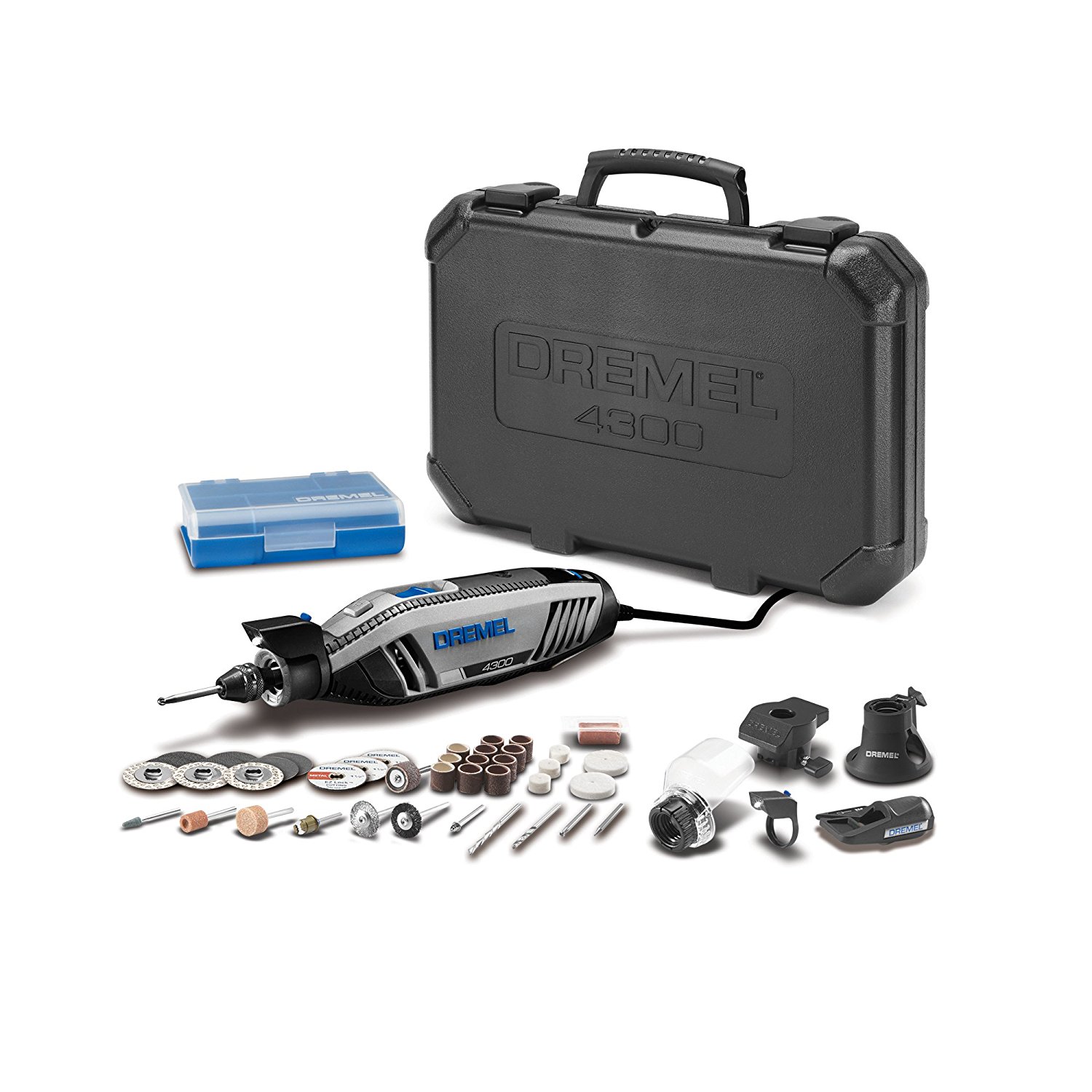Review: Dremel 4300 High Performance Corded Rotary Tool
If you are in the market for a rotary tool or are looking to upgrade to a more durable, high performance tool, consider the Dremel 4300. The tool is corded (6 feet), 120V, runs at 5,000 to 35,000 RPM variable pulling 1.8 amps, and is considered to be the ‘top of the line’ rotary tool offered by Dremel.
Specifications
- Cord Length: 6ft
- Speed: Variable (5,000 to 35,000 RPM)
- Weight: 1.9kg
- Length: 9”
- Width: 1.5”
- Height: 3.7”
- Amperage: 1.8A
- Voltage: 120V
- Warranty: Limited 2 Years
Design
Compared with other Dremel rotary tools, the Dremel 4300 offers more power in a larger body (at a slightly higher price than the 3000 series). The design is similar to the rest of the Dremel rotary tool family including a hard plastic exterior with gripping rubber and vent openings. The tool is generally comfortable to hold.
Note: The venting system is supposed to improve air flow, but many users still found the tool to become very hot near the output in the front. If you are doing anything requiring fine detail, it is not advised to cover the fan vents in the front even though it may be more comfortable to do so.
More power does not necessarily mean more control and stability. Although the tool does generally stably operate, the larger diameter of the tool body and the location of the vented airflow makes it more difficult to operate precisely. The other limiting factor in this area is the poor quality of the Dremel cord (similar to all other Dremel rotary tools). The cord plastically forms and kinks easily and can get in your way if you are looking for precision. Over time (like most cords), the constant flexing and straightening of the cord will loosen it a little.
The included box is nothing to write home about. Although it is built with quality material (thick molded plastic), the tool and accessories do not efficiently fit or lock into place. If every tool and accessory is not in the box, the tools will move through the empty space. If you have some foam available, it would be advised to cut a piece and place it in the case to better secure the tool.
Chuck
The Dremel 4300 is the first in its family to offer a universal three-jaw chuck requiring no tool or collet to change accessories. By switching to a three-jaw chuck, Dremel has opened up accessory compatibility, accepting Dremel accessories (and other tools) of most sizes and shapes. In some cases, the three-jaw chuck may need to be removed and replaced with a standard collet to better accept tools that don’t quite fit properly.
Note: Dremel is aware that the standard chuck is not compatible with all accessories and applications, so they provided a collet system that can be switched into the the rotary tool in place of the chuck.
A standalone accessory that is included with the 4300 is the Pivot Light that does what it says… pivots 360 degrees to fully illuminate the work zone. The light is powered with its own battery rather than through the 120V power source. The only problem with it is it takes up valuable space otherwise used by attached accessories and in some cases needs to be removed to accommodate.
Power and Motor
Another feature that sets this tool apart from the Dremel rotary tool family is the presence of a standalone power switch. Rotary tools generally are powered on using the variable motor speed wheel. In the case of the Dremel 4300 (as well as the 4200 and 4000), the variable motor speed wheel is separate from the power switch. This allows you to consistently work with a single motor speed even if you need to turn the tool of in the middle of an operation.
The motor is more powerful than many of its family members, pulling 1.8 amps (as opposed to 1.6 amps pulled from the Dremel 4000 motor). The motor is variable, offering a range between 5,000 RPM and 35,000 RPM, and includes electronic feedback to improve stability at different speeds. Like many Dremel tools, the parts are user accessible and serviceable including the motor brushes.
Even with the additional design considerations by Dremel, the 4300 still has issues with power at lower RPSs - in the 5000 to 8000 RPM range. If you are working with metal or hard wood, it is not uncommon for the motor to stop at low RPMs if you are applying a lot of pressure.
At higher speeds, the Dremel 4300 works very well and the larger body makes it feel very stable. It has been noted by some users that at very high RPMs - in the 30,000 to 35,000 RPM range - the vibrations can cause the three-jaw chuck to loosen. If this is the case, use caution prior to using the tool at high RPMs with new accessories and materials. If necessary, replace the three-jaw chuck with the included collet system to better secure the tool.
Kits
The Dremel 4300 is sold in kits that include the rotary tool, attachments, and accessories. Shopping for the kits, you will see part numbers in the form of Dremel 4300-x/xx. The first number after the 4300 is the quantity of attachments in the kit, and the second number is the number of accessories.
For example, the Dremel 4300-5/40 kit includes 5 attachments and 40 accessories as well as the rotary tool and the travel box.
Jarrett Linowes
Mechanical Engineer
omniamfg@gmail.com
Did I miss anything you are interested in? Send me an email or comment below!







